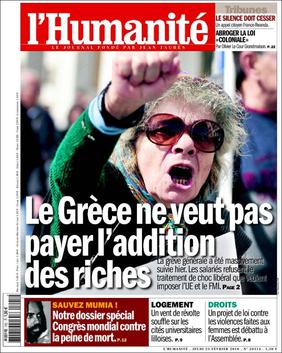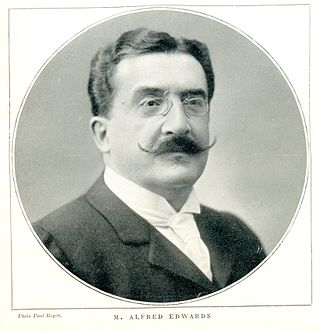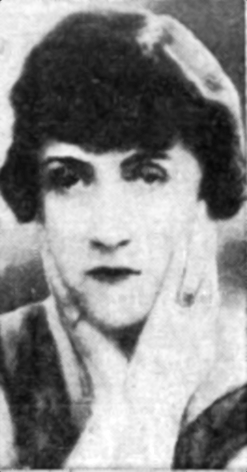
Le Matin was a French daily newspaper first published in February 26, 1884, [1] and discontinued in 1944.

Le Matin was a French daily newspaper first published in February 26, 1884, [1] and discontinued in 1944.
Le Matin was launched on the initiative of Chamberlain & Co., a group of American financiers and the American newspaper editor Samuel Selwyn Chamberlain, [2] in 1883, on the model of the British daily The Morning News . The direction of the project was entrusted to the French journalist Alfred Edwards, [3] who launched the first issue on 26 February 1884. His home was then situated in the 10th arrondissement of Paris, at 6 boulevard Poissonnière, and his offices at numbers 3 to 9 on the same street.
A few months later, Edwards left Le Matin to found his own journal, Le Matin Français, which soon surpassed the circulation of Le Matin. Later Edwards bought Le Matin and merged the two papers. He modernized the resulting hybrid with the most modern techniques and technologies such as the telegraph, and signed great writers such as Jules Vallès and the député Arthur Ranc. Le Matin was thus favourable to moderate republicans and opposed to Boulangisme and socialist ideas.
Implicated in the Panama scandals, Edwards re-sold the newspaper in 1895 to the banker and advertiser Henri Poidatz, who invested considerably in advertising in it. The journal was particularly notable during the Dreyfus affair, as early as 1896 questioning the withheld evidence against the officer accused of treason and publishing in July, 1899 the confessions of commandant Esterhazy.
In May 1899, the newspaper followed a proven publicity and readership recruitment model by organising the Tour de France Automobile in conjunction with the Automobile Club de France. The newspaper's price rose to 5 centimes, like the majority of papers in this era, and its number of pages rose from 4 to 6. The same year the businessman Maurice Bunau-Varilla, at first one of the paper's shareholders, joined its board of directors, becoming its president in 1901. Borne along by effective advertising, by the catchy tone of its articles and its brave reporting, Le Matin continued to increase its circulation, from 100,000 copies in 1900 to around 700,000 in 1910 and more than a million around 1914. [4] Le Matin was thus one of the four biggest daily French newspapers in the period before World War I, employing 150 journalists such as Gaston Leroux, Michel Zevaco and Albert Londres, along with 500 technicians and other workers. Félix Fénéon's Nouvelles en trois lignes appeared anonymously throughout the paper in 1906. In 1918, it made the first recorded use of jazband (French for a jazz band), and was subsequently cited in both Über englisches Sprachgut im Französischen and Grand Larousse Dictionnaire de la Langue Française although they mis-typed the date as 1908. Also in the inter-war period the paper had the Russian-exile cartoonist Alex Gard on its staff.

Le Matin's political leanings moved progressively towards nationalism and, after World War I, were openly anti-parliamentary and anti-Communist. It approved of collaborationist policies in June 1940 and adopted a pro-Nazi line before disappearing on 17 August 1944, a few days after the death of Maurice Bunau-Varilla. [5]

L'Humanité is a French daily newspaper. It was previously an organ of the SFIO, de facto, and thereafter of the French Communist Party (PCF), and maintains links to the party. Its slogan is "In an ideal world, L'Humanité would not exist."

Le Temps was one of Paris's most important daily newspapers from 25 April 1861 to 30 November 1942. It was a serious paper of record.

La Croix is a daily French general-interest Catholic newspaper. It is published in Paris and distributed throughout France, with a circulation of 91,000 as of 2020.

Philippe-Jean Bunau-Varilla was a French engineer and soldier. With the assistance of American lobbyist and lawyer William Nelson Cromwell, Bunau-Varilla greatly influenced Washington's decision concerning the construction site for the Panama Canal. He also worked closely with President Theodore Roosevelt in the latter's orchestration of the Panamanian Revolution.
France Soir was a French newspaper that prospered in physical format during the 1950s and 1960s, reaching a circulation of 1.5 million in the 1950s. It declined rapidly under various owners and was relaunched as a populist tabloid in 2006. However, the company went bankrupt on 23 July 2012, before re-emerging as an online-only media in 2016. In 2020, according to NewsGuard, this media "fails to adhere to several basic journalistic standards".

La Voix du Nord is a regional daily newspaper from the north of France. Its headquarters are in Lille.

Le Petit Journal was a conservative daily Parisian newspaper founded by Moïse Polydore Millaud; published from 1863 to 1944. Together with Le Petit Parisien, Le Matin, and Le Journal, it was one of the four major French dailies. In 1890, during the Boulangiste crisis, its circulation first reached one million copies. Five years later, it had a circulation of two million copies, making it the world's largest newspaper.
Maurice Bunau-Varilla was a French press magnate, and proprietor of the newspaper Le Matin. During the Second World War, he made the newspaper's editorial line pro-German and pro-collaborationist, and it ceased publication 16 days after his death. Bunau-Varilla admired Adolf Hitler more out of his anti-Communist leanings than out of Nazi conviction.

Alfred Charles Edwards was a journalist and magnate of the French press.

Le Petit Parisien was a prominent French newspaper during the Third Republic. It was published between 1876 and 1944, and its circulation was over two million after the First World War.

L'Aurore was a French newspaper first sold on 11 September 1944, soon after the Liberation of Paris. Its name refers to the previous, unrelated publication, L'Aurore (1897–1914). Publication ended in 1985.
Varilla may refer to:

Jeanne-Marie Matthey-Jonais was a French tennis player. She competed during the first two decades of the 20th century. Matthey won the French Open Women's Singles Championship four times in succession from 1909 to 1912, but lost the 1913 final to Marguerite Broquedis.
L'Écho de Paris was a daily newspaper in Paris from 1884 to 1944.

Newspapers have played a major role in French politics, economy and society since the 17th century.

Jean Victor Charles Edmond Leune was a French war correspondent, writer, press photographer, military aviator and member of the French Resistance.

Valentine Mathilde Amélie Thomson was an influential French journalist, playwright and editor, who was active both in Europe and the United States. Daughter of the left-wing politician Gaston Thomson, in 1919 she was a delegate at the Inter-Allied Women's Conference which sought to introduce women's issues to the peace process following the end of the First World War. In Paris, in collaboration with her husband, the journalist and screenwriter André Jaeger-Schmidt (1884–1940), she wrote plays which were staged in Paris and the provinces. In the late 1920s she moved to the United States where she wrote about international politics for a variety of papers including the New York Times and Harper's Magazine. She was also known for the salons she held with prominent figures of her times.

The clandestine press of the French Resistance was collectively responsible for printing flyers, broadsheets, newspapers, and even books in secret in France during the German occupation of France in the Second World War. The secret press was used to disseminate the ideas of the French Resistance in cooperation with the Free French, and played an important role in the liberation of France and in the history of French journalism, particularly during the 1944 Freedom of the Press Ordinances.

Suzanne Bertillon was a prominent French figure before and during World War II, whose various roles included decorator, journalist, lecturer, and resistance fighter. She was a laureate of the Resistance Medal, the Croix de Guerre 1939–1945, the Cross of the Legion of Honour, and the Medal of Freedom with bronze palm.